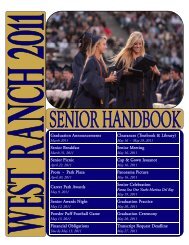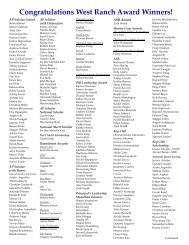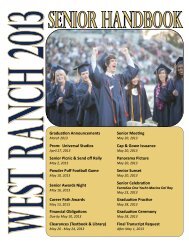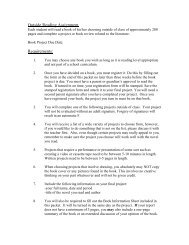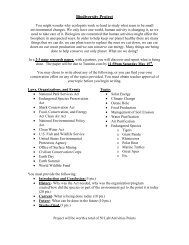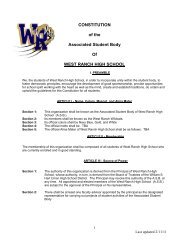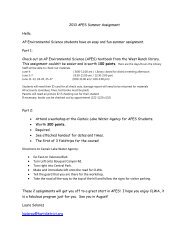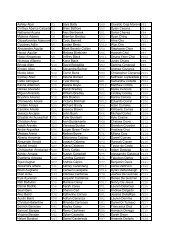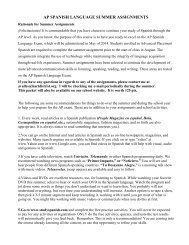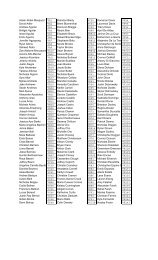Chapter 9 The Late Middle-Ages: Social and Political Breakdown ...
Chapter 9 The Late Middle-Ages: Social and Political Breakdown ...
Chapter 9 The Late Middle-Ages: Social and Political Breakdown ...
Create successful ePaper yourself
Turn your PDF publications into a flip-book with our unique Google optimized e-Paper software.
AP European History<br />
Summer Assignment 2011<br />
Due: First class - either August 18 or 19 depending on even or odd scheduled class<br />
This assignment can be done once you get your textbook, <strong>The</strong> Western Heritage, at<br />
registration on August 11.<br />
Goal: <strong>The</strong> goal of the summer assignment is to give you a basic underst<strong>and</strong>ing of the<br />
events that came before the Renaissance. This is important because you will need a<br />
basis for underst<strong>and</strong>ing how the Renaissance changed European society. It is difficult to<br />
underst<strong>and</strong> or even recognize that change unless you are familiar with what came<br />
before.<br />
<strong>Chapter</strong> 9 <strong>The</strong> <strong>Late</strong> <strong>Middle</strong>-<strong>Ages</strong>: <strong>Social</strong> <strong>and</strong> <strong>Political</strong> <strong>Breakdown</strong> (1300 –<br />
1527)<br />
Part I: Terms<br />
Identify the following terms. Remember to explain each term within the appropriate<br />
historical context. In general, explanations should be 1 – 2 complete sentences. Some<br />
will require more detailed explanations than others <strong>and</strong> therefore will be longer. <strong>The</strong>se<br />
terms are covered in <strong>Chapter</strong> 9 in your text <strong>The</strong> Western Heritage. In addition to your<br />
book, you may use encyclopedia articles or the internet.<br />
Great Schism<br />
the Avignon Papacy<br />
Treaty of Troyes<br />
Joan of Arc<br />
John Ball<br />
Council of Basel<br />
Jacquerie<br />
Philip IV<br />
John Huss<br />
Unam Sanctam<br />
Council of Constance<br />
John Wycliffe<br />
Council of Pisa<br />
Marsilius of Padua<br />
longbow<br />
Hundred Years War<br />
Estates General<br />
Pogroms<br />
Taille<br />
Unam Sanctam<br />
Lollards<br />
Conciliar <strong>The</strong>ory of<br />
Church Gov.<br />
Black Death<br />
Part II: Questions<br />
After reading the entire chapter, please answer each of the following questions in one<br />
short, well thought out paragraph using complete sentences.<br />
1. What are the three great calamities developed in the <strong>Chapter</strong>? Make sure you give a<br />
short explanation of each.<br />
2. What portion of the population is estimated to have been decimated by the Black<br />
Death? What are the consequences of losing such a large portion of the population<br />
3. What book is an excellent source for underst<strong>and</strong>ing the reaction of the people to the<br />
Black Death? Why?<br />
4. In peacetime, what were the favorite amusements of the nobility in the <strong>Middle</strong> <strong>Ages</strong>?<br />
5. What was the process of attaining knighthood?<br />
6. What was the purpose of “tournaments”?<br />
7. <strong>The</strong> clergy of the <strong>Middle</strong> <strong>Ages</strong> were divided into what two groups? Explain how they<br />
were different.<br />
8. What were the duties of the secular clergy?<br />
9. In the <strong>Late</strong> <strong>Middle</strong> <strong>Ages</strong>, why were the clergy resented by the townspeople?<br />
10. Whose works became the primary focus for scholastic study?
11. What was the purpose of St. Aquinas’ Summa <strong>The</strong>ologica ?<br />
12. How did Christian theologians of the period depict women? How do you think this<br />
influence the way society saw women <strong>and</strong> how they were treated?<br />
13. What effect did the high infant <strong>and</strong> child mortality rate of the <strong>Middle</strong> <strong>Ages</strong> have on<br />
parents?<br />
Part III: Primary Source Documents<br />
Read the following Primary Source Documents from the chapter <strong>and</strong> summarize them in<br />
YOUR OWN WORDS. <strong>The</strong>n answer the questions beside the red box on the page.<br />
1. Boccaccio Describes the Ravages of the Black Death in Florence (page 300)<br />
2. Marsilius of Padua Denies Coercive Power to the Clergy (page 306)<br />
3. <strong>The</strong> Chronicler Calls the Roll at the Council of Constance (page 310)<br />
Part IV: Art & <strong>The</strong> West (page 315)<br />
Answer the questions on page 315 regarding death as it was depicted in medieval art.




